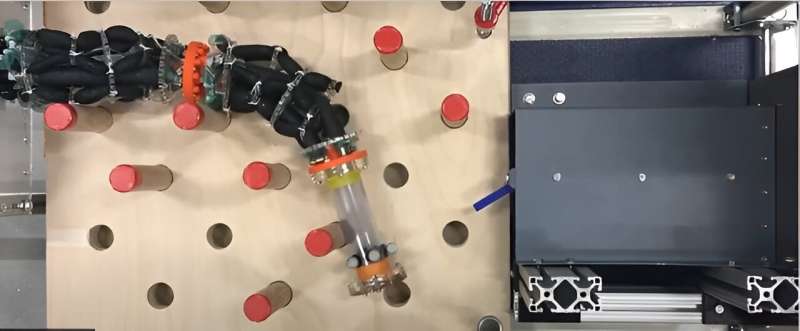September 5, 2023 report
This article has been reviewed according to Science X's editorial process and policies. Editors have highlighted the following attributes while ensuring the content's credibility:
fact-checked
peer-reviewed publication
trusted source
proofread
Targeted stiffening yields more efficient soft robot arms

The current crop of AI robots has made giant leaps when it comes to tiny activities.
There are robots performing colonoscopies, conducting microsurgeries on blood vessels and nerve cells, designing circuit boards, constructing delicate timepieces and conducting fine touch-up operations on fading, aging classical paintings by the masters.
Robots are able to handle delicate objects thanks to what researchers call passive compliance. That is the ability to change their state in response to specific tasks.
Their "hands" can adjust their form, for instance, to accommodate oddly shaped instruments. Or they can adjust pressure used to grasp items ranging from heavy boxes to fragile flasks containing volatile chemicals to performing delicate surgeries.
Such passive compliance allows robotic structures to yield or deform in response to external forces they encounter. It ensures more efficient interactions with human subjects and, more importantly, safer operations.
Harvard University researchers have noted, however, that greater efficiency and safety come at a cost. Passive compliance, they say, restricts payload capacity, placing limits on the kinds of activities robots can tackle.
So they designed a model incorporating improvements that have the potential "to improve the efficacy [of robotic arms] in a variety of tasks including object manipulation and exploration of cluttered environments," according to a paper published Aug. 30 in Science Robotics.
These "soft robot arms" incorporate the idea of localized body stiffening that in effect strengthens the arm and permits handling of greater payloads. Such hardening is achieved through the use of variable stiffness actuators (VSAs) that control arm pliability through the use of lever-arm and spring mechanisms, shape-memory materials and temperature-dependent components.
"VSAs allow rigid-bodied robots to actively tune their built-in compliance during operation, enabling faster and safer motion control," said Daniel Bruder, an author of the study, "increasing the payload capacity of soft robot arms by localized stiffening."
Observers can see the concept of variable stiffening at play in nature. The sea cucumber uses stiffening to save itself from predators, hardening its shell in an instant when threatened. Sea cucumbers exhibit flexibility when burrowing themselves in the muddy sea floor, but stiffen up when they need to anchor in place.
"Our hardware experiments demonstrate the practical benefit of adjustable compliance and the feasibility of implementing this capability via antagonistic actuation," Bruder said.
Researchers at MIT tackled the same issues. The institute's Computer Science and Artificial Intelligence Laboratory, working with the Toyota Research Institute, developed a robot that could hold items and apply a finely tuned amount of force to execute a task, such as writing out word with a pen or pressing out liquid through a syringe.
The system, called Series Elastic End Effects, used soft bubble grippers and cameras to screen activity over six-dimensional space—left and right, up and down, back and forth, yaw, roll and pitch.
As explained in an MIT blog post last year, "Rigid-bodied robots and their counterparts can only take us so far; softness and compliance affords the luxury and ability to deform, to sense the interaction between the tool and the hand."
According to Harvard's Bruder, his team's research will lead to far more capable robotic arms in the future "by increasing their payload capacity without sacrificing their ability to use compliance to navigate in obstacle-rich environments and to safely interact with humans and delicate objects."
More information: Daniel Bruder et al, Increasing the payload capacity of soft robot arms by localized stiffening, Science Robotics (2023). DOI: 10.1126/scirobotics.adf9001
© 2023 Science X Network

















